Exotic Fish
Exotic Fish fish species that are of foreign origin and introduced to Bangladesh to augment fish production. History shows that the introduction of individual fish species occurred in different times. So, it would be difficult to provide a comprehensive account of such introduction since no systematic record has been maintained. However, Chinese silver carp, grass carp, big-head carp, black carp and the common carp are the major exotic fishes that have been introduced during the last few decades in Bangladesh waters. Various sources noted that the tilapia (Oreochromis mossambicus), introduced in 1954, was the first exotic piscine in Bangladesh. A vast majority of the 150 exotic species introduced into the country in the last 2-3 decades are mostly ornamental or aquarium fish. A larvivorous fish, Gambusia was introduced between the 1930s and the 1940s to control mosquitoes. Among the pond fish, grass carp (Ctenopharyngodon idellus) was officially introduced in 1966, while the silver carp (Hypopthalmicthys molitrix) was introduced in 1967. However, many of today's popular pond fishes entered into the country crossing the border unofficially. Having been introduced with or without authorization, most of the species established themselves and became popular among the aquaculturists. While the introduction of some of the species proved to be suitable for pond culture, the introduction of exotic fish into open waters indiscriminately is open to debate.
The major species of exotic varieties that have contributed substantially to commercial fisheries are the Chinese silver carp, grass carps, big-head carp, common carp, tilapia, catfishes, Thai magur, Thai pangas, rajputi, etc. A brief account of some important pond fishes are given below:
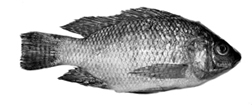
Tilapia was first introduced in 1954 from Thailand. Another consignment of O. niloticus was brought in 1974 from Thailand under UNICEF/DOF joint project. A small stock of tilapia from Thailand was brought by the Fisheries Research Institute in 1987.
The original habitats of tilapia are the rivers along the east coast of Africa from Algoa Bay in South Africa to the West Shebeli river in Somaliland.
The species thrives well under the pond habitat. It is however, more suitable for rearing in the shallow and small ponds. The fish is familiar for its impressive growth. It attains 200-350g in 4 to 6 months. No special technique is necessary for its breeding or spawning.
The common carp is popularly known as 'Carpio'. Though the actual time of its introduction is not definitely known, the official sources indicate that it was introduced in 1960. There is evidence that the fish was brought from India where it was introduced in 1939.
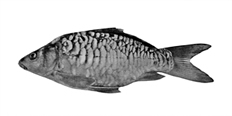
The fish is native to the temperate regions of Asia, especially of China. Now, it is globally distributed and occurs in tropical and subtropical regions. There are many varieties of common carp. The most popular varieties are the scale-carp Cyprinus carpio var. communis; the mirror carp C. carpio var. specularis, and the leather carp C. carpio var. nudus.
The common carp is remarkable for its habit of acclimatising to a variety of habitats and environmental conditions. It has a wide range of food habits. The young feed on zooplankton. Later in life they feed chiefly on bottom invertebrates. They also consume algae, detritus, decaying plant matter, etc. In pond conditions, they readily accept a wide variety of prepared supplemental feeds. In Bangladesh conditions, the fish becomes mature within six months and breeds twice a year during winter and in summer.
Silver carp (H. molitrix) was introduced in 1969. The fish was imported from Hong Kong. Among exotic fishes, the silver carp has attracted more attention from ecologists and fishery managers, because of its impressive growth rate and ability to live harmoniously with other carp species.
The silver carp naturally occurs in the river systems of south and central China and in the Amur Basin in USSR. The species has been introduced into many countries in recent years for aquaculture. It has become one of the most important fish species in the pond polyculture system in Bangladesh. The fish breeds naturally during April-July in the flowing waters of its natural habitat.
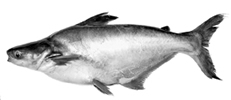
Bighead carp (H. nobilis) was introduced in 1981 from Nepal. It naturally occurs in the riverine system of China. The fish does not breed in captivity. Generally, the female attains maturity in 3-5 years, while the male takes about a year.
Grass carp (C. idellus) is a natural inhabitant of the flatland rivers of China and the middle and lower reaches of the river Amur in the USSR. The first consignment of grass carp came to Bangladesh from Hong Kong in 1966. In Bangladesh the fish has been proved to be a good biological control agent for aquatic weeds. It has specialized pharyngeal teeth for rasping aquatic vegetation. It has been found to be quite effective in controlling weeds such as Najas, Hydrilla, Wolfia, Lemna, Azolla, Salvinia, etc. However, the fish has diversified food habits. In the running waters grass carp breeds in the monsoon, but does not spawn naturally in stocked conditions.
Black carp was introduced in 1983 from China. It mainly feeds on live snails and is therefore often known as snail carp.
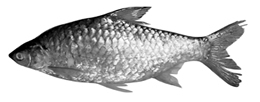
Rajputi also known as Thai sarputi (Puntius gonionotus), the fish was brought in 1977 from Thailand. It is an inhabitant of the Southeast Asian riverine system. It has a resemblance with the local sarputi (Puntius sarana) and may grow up to 20 cm. Rajputi does not spawn in captivity. In natural habitats, it breeds in flowing rivers or canals. In Bangladesh habitat, rajputi attains maturity in one year. The fish is suitable for cultivation in small shallow waterbodies and ditches. It is also a recommended species for polyculture with some other species.
African magur (Clarias gariepinus) was brought in 1989 from Thailand although it is a native of Africa. It is a very hardy fish and can stand in water containing oxygen as low as 0.02 ppm. African magur is omnivorous in feeding. At the young stage, it has high tendency of predation.

In nature the African magur may attain maturity within one year. In rearing ponds its growth performance depends on the management practices. In extensive practices, the fish grows to marketable size in 8-12 months. But under semi-intensive pond management systems, the table fish could be reared in every 3-4 month period. This fish can attain a weight of up to 4 kg.
Thai pangus (Pangasius sutchi) was imported from Thailand in 1989. Its natural habitat is the Southeast Asian freshwater system. The fish is highly tolerant to the changes in salinity, pH, dissolved oxygen or even pollution. It is omnivorous in food habits and takes crustaceans, mollusks, fish, and vegetable wastes.
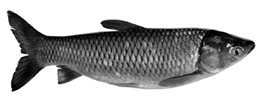
Among other exotic fishes mention may be made of the milkfish (Chanos chanos) which was imported officially in 1979. Milkfish is found in warm offshore waters of the Red Sea, the Indian Ocean, and the Pacific Ocean. Its availability is also reported from the Bay of Bengal. It is best suited for culture in brackish-water. Some private entrepreneurs of Satkhira are maintaining its cultivation using imported seeds from Thailand. The bangladesh fisheries research institute also imported its seeds in 1998 for rearing and breeding in its marine station.
Although Mohashol (Tor tor) is a local species, and is distributed throughout the upper regions of Mymensingh, Sylhet and Dinajpur basin riverine systems, a consignment of this fish has been brought from Nepal and is being raised in a Freshwater Station of the Bangladesh Fisheries Research Institute.
Genetically Improved Farmed Tilapia (GIFT) was brought in Bangladesh from the Philippines in 1994. The new strain of O. niloticus was developed through several generations of selection involving eight different pure breeds of Nile tilapia. [Md. Shahadat Ali]
